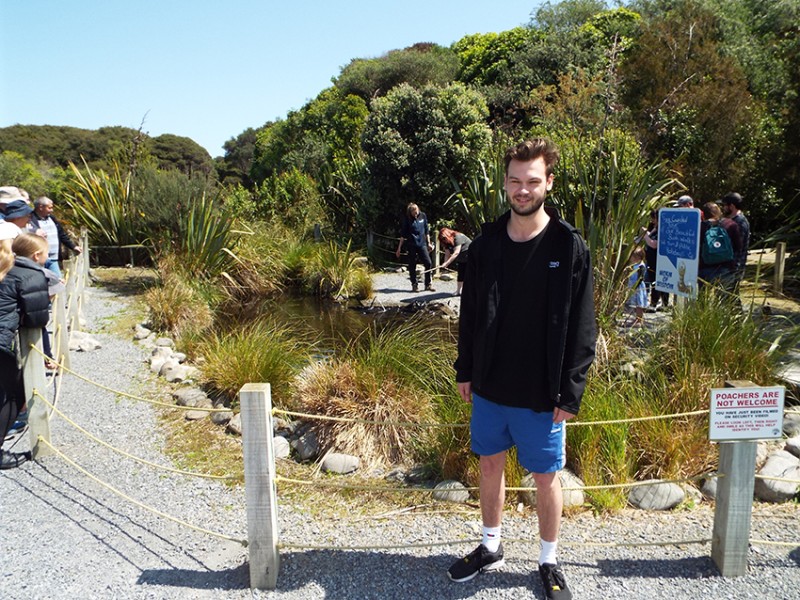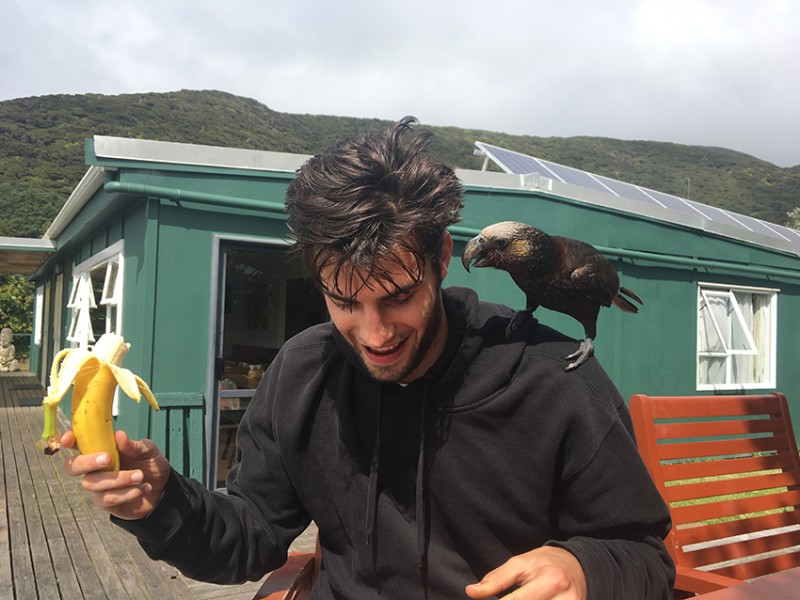

Where kiwis tread and birds sing by Sam Hollis
Kāpiti (Summer 2019)
I arrived in Kāpiti excited for a new experience. As a South Islander, I’m ashamed to say I am not as well versed in the North Island’s marvels as I’d like to be. Over three days, my friend Jeremy and I found a new appreciation for our country’s native wild and forest life thanks to the wonderful guides and people we shared our time with at Ngā Manu Nature Reserve and Kāpiti Island.
We departed Wellington by car on Saturday morning. I didn’t even have to sacrifice my signature sleep in, as Ngā Manu is under an hour away via the motorway. We stocked up on snacks and barbeque supplies and made it to the reserve by 10:30am. Soon we were greeted by friendly staff who checked us into Theo’s Cottage, a quaint little home away from home. We began with a tour of the many enclosures with Rhys, who set the tone for all those who helped us throughout the weekend: friendly, fun, and above all else, passionate. We saw kākā, tuatara, North Island brown kiwi, and more before firing up the barbeque and eating amongst the natural surroundings. What was immediately noticeable were the distinct personalities of each species; shout out to Jimmy, a kea who spent the majority of his time with us staring at his own reflection in a mirror (I can’t say I blame him).
Next, we joined some other visitors and fed the eels with Lucy. She introduced us to Joy, who took us through the lowland swamp forest, which showcased the size of Ngā Manu (15 hectares in total) and the scope of what they achieve as a nature reserve. This one was all about the trees, and our short tour came with a story around every corner. It felt as though we had stepped back in time, experiencing the wonderful variety of flora that would have been common in New Zealand 200 years ago.
It was mid-afternoon, and we were glad to take some time to explore on our own. We sat in silence by Top Pond to soak in the sights and sounds as something new grabbed our attention each time we swivelled our heads.
We travelled off-site for dinner, equipped with a helpful list of recommended restaurants from Ngā Manu. We failed to account for the fact that England was battling South Africa for the Rugby World Cup that night and had to sit at an outside table at Long Beach Tavern on Waikanae Beach, which turned out to be a blessing in disguise on the still, warm night. Even better than the location was the food. We opted to split two pizzas between us accompanied by chilli cheese fries, a garden salad, and a glass of Laphroaig. Even after a long day we couldn’t finish it, overestimating our hungry stomachs. Still, I’m never mad at leftover pizza. Afterwards, we climbed the bank across the road to nab a view of the beach at sunset before making our way back.
Back at the reserve we met Matu for the kiwi night encounter. He told us beforehand that the others who were booked to join us had pulled out at the last minute; they missed out! Thus the tour became even more intimate and we enjoyed the freedom to fire questions at Matu whenever we wanted. Frankly, I was shocked at how little I knew about our national symbol. He let us hold a model of a North Island brown’s egg, which can weigh up to 450 grams, the equivalent of a woman carrying a six-year-old child! We headed out to the enclosure cautious of every step as we desperately tried not to startle the two kiwis wandering around. A dim red light provided us with just enough vision. Although we entered at what is usually their feeding time, these kiwis were less interested in their dinner and more interested in… how should I put this? Each other. Even Matu was surprised at their behaviour and said he’d never heard the pair make so much noise. Still, we managed to catch sparse glimpses of the birds, which felt more special than I had considered it would. Jeremy and I thoroughly appreciated our honest conversations with Matu. He explained Ngā Manu’s philosophy on the rehabilitation of native species and how the territorial nature of the kiwi (they are surprisingly intolerant of one another) complicates the process. It is important that people take the opportunity to see these birds with their own two eyes to appreciate how rare they really are.
The next morning was not as luxurious as the one prior as we had to make sure we were up and at ‘em in time to catch the ferry to Kāpiti Island by 8:30am. We drove for 20 minutes, checked our bags for any uninvited guests, and wiped our shoes clean of any mainland remnants. The ferry was quick and painless, taking only 15 minutes. Stepping off the boat felt like stepping into an alternate reality. Kāpiti Island Nature Tours guide Rose led us to a small hall and gave our group of around 25 people a rundown on the island’s history, what to expect on our travels, and how to treat it respectfully. The island is about 10 kilometres long and two kilometres wide, a true paradise for flora and fauna. In 1897, Prime Minister Richard Seddon introduced a bill to Parliament that recognised Kāpiti Island’s diverse abundance of native species, making it one of the oldest lands in the world to be recognised as a wildlife sanctuary. Today it is completely predator-free.
Rose explained the two possible routes towards the summit, the zigging and zagging Wilkinson Track or the straight and steep Trig Track. Pfft, steep… yeah it was really steep, and we did have to take a few breaks to reboot. Thankfully, we found it was an experience worth taking our time with. Aurally, there were sounds all around us that piled mystique onto the already entrancing world. Visually, the forest began to fog and dampen, and the sunlight cutting through the branches made the climb feel transcendent. Sadly, the fog stuck with us at the peak and what I’m sure would have been a stunning view was spoiled by sheets of white. The walk descending the Wilkinson Track was an entirely different exploit as we got our first proper glimpses of the array of birds present on the island, including hihi, weka, and a particularly ostentatious kākā. While the return walk was estimated to take three and a half hours, we sped through it in about two. I’d recommend you slow it down and take your time, particularly if you only intend to stay for the day.
We boarded the ferry at 3pm and crossed to the north end of the island where we would be lodging for the night. We walked up to the lodge with a group of roughly 15. It was wonderful that we shared this time with others; every person had a unique background and their own reason for being there. Manaaki was to be our host for the evening, and he began by filling us in on his fascinating family, who reside on and protect the island to this day. He checked us into our hut, which was appropriately minimal with only two bunk beds to its name. The beauty of them was their location. You only needed to step through the sliding doors to come face to face with colourful kererū, tūī, tīeke, kōkako, and more.
Manaaki joined us for a get-to-know-you session over wine, cheese, nuts, and vegetables before dinner. We then readied ourselves for the highly anticipated kiwi-spotting tour. The island is home to between 1200 and 1400 little spotted kiwi, the largest individual population anywhere. We split into two groups, formed a line, and headed out with only a red light to guide us. There are no guarantees here, either you see some or you don’t, which is why we were absolutely stunned when a rambunctious little kiwi ran right across our path, stepping over Jeremy’s feet. While Manaaki attempted to follow it with his light we drew his attention to a spot in the bushes where another one stood mere metres away. We spotted one more deeper in the forest, along with some gecko and tree weta.
Our return ferry was booked for 3pm the next day, which gave us plenty of time to explore the western end of the island. This end was inhabited by gulls; when I say inhabited, I’m talking Alfred Hitchcock’s The Birds kind of inhabited. Don’t worry, they left us alone, although we almost made the fatal mistake of venturing into a nesting area, which would have been an experience in itself. This concluded our time on the island. We packed up, said our goodbyes, and headed back to the mainland and home to Wellington.
Between our time with the good people of Ngā Manu Nature Reserve and Kāpiti Island Nature Tours, we had a fun, comfortable, and educational experience in Kāpiti. For tourists, I’d recommend this trip as an escape from suburbia into native New Zealand. For Kiwis, I feel it is even more important. It truly puts the exclusivity of these creatures and plants into perspective and gives you the unique opportunity to see them in an environment where they thrive. Seeing this made us wish they could do the same on our main islands. It’s a weekend away that you’ll enjoy at the time and be even more grateful for long after.
View more articles:
« Back to 'Travel Experiences'
